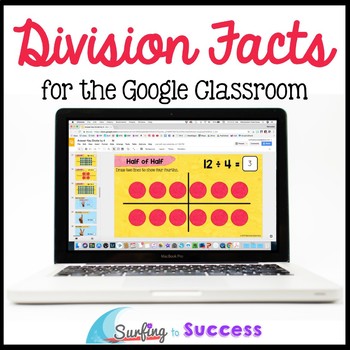Division Facts, Strategies, & Games for the Google Classroom & Distance Learning
- PDF
- Google Apps™

What educators are saying
Description
This Google Slides Resource works well for Distance Learning. Improve memorization and help students divide fluently with this digital Google Slides Resource by focusing on unknown factor and other division strategies. Division strategies include using arrays, creating equal groups, fact families, skip counting, using multiplication to divide, strip diagrams, half, half of half for dividing by 4, and half of half of half for dividing by 8. Fun, self paced, differentiated division practice motivates students to pass each assessment.
This can be used with 3rd graders to introduce divisions or with 4th-6th graders and SPED students to provided targeted intervention.
Includes:
Teacher’s Manual
When you click the link provided in the PDF download, you make a copy of the Teacher’s Manual which is in Google Slides. The manual contains instructions and links to all the student assignments, 10 digital assessments, and the answer keys.
9 Student Slide Decks
A student slide deck is included for Dividing by 2-10. Each slide deck contains about 45 slides with 4 different strategies to practice. Each new strategy has an instructional gif to show students visually what they should do. At the end of each slide deck is a review slide where students look for patterns which contains a link to digital flash cards. There is also a Keep Practicing slide which contains a YouTube video and links to division games. This slide is editable so you can change the video and games.
10 Assessments
Assessments are provided through links to 10 Quizizz. Quizizz is a free fun assessment website that connects with Google Classroom. There is an assessment for 2 – 10 and a mixed assessment of all division facts that can be used as a pre and post. If you want to differentiate, you can let students take each Quizizz and a pretest and when they reach one that is challenging, you can assign the corresponding slide deck.
Google Sheets for Data Tracking
A Google Sheet is provided for tracking student assessment scores. One is also provided for those of you that use Quizizz but don’t have Google Classroom. This sheet lets you display codes kids can use to take a quiz.
Answer Keys
Links to 9 answer key slide decks are also included in the teacher’s manual.
⇒⇒Update April 14, 2018: Printable timed tests have been added by request.
The amount of time needed will vary. My third graders took eight 40 minute class periods to complete the 2s slide deck. My 4th and 5th graders times vary with the slide decks with the shortest amount I've seen being about 80 minutes for one slide deck. Students who have access internet at home can work outside of class.
The slide number total does not include the answer keys, repeated slides, cover pages, or digital assessments.
Many people who had my Multiplication Facts for the Google Classroom resource requested that I make one for division. If you don't already have the multiplication resource, check it out! :)
Standards Addressed:
CCSS.MATH.CONTENT.3.OA.A.2
Interpret whole-number quotients of whole numbers, e.g., interpret 56 ÷ 8 as the number of objects in each share when 56 objects are partitioned equally into 8 shares, or as a number of shares when 56 objects are partitioned into equal shares of 8 objects each.
CCSS.MATH.CONTENT.3.OA.A.4
Determine the unknown whole number in a multiplication or division equation relating three whole numbers.
Understand properties of multiplication and the relationship between multiplication and division.
CCSS.MATH.CONTENT.3.OA.B.5
Apply properties of operations as strategies to multiply and divide. Examples: If 6 × 4 = 24 is known, then 4 × 6 = 24 is also known. (Commutative property of multiplication.) 3 × 5 × 2 can be found by 3 × 5 = 15, then 15 × 2 = 30, or by 5 × 2 = 10, then 3 × 10 = 30. (Associative property of multiplication.) Knowing that 8 × 5 = 40 and 8 × 2 = 16, one can find 8 × 7 as 8 × (5 + 2) = (8 × 5) + (8 × 2) = 40 + 16 = 56. (Distributive property.)
CCSS.MATH.CONTENT.3.OA.B.6
Understand division as an unknown-factor problem. For example, find 32 ÷ 8 by finding the number that makes 32 when multiplied by 8.
Multiply and divide within 100.
CCSS.MATH.CONTENT.3.OA.C.7
Fluently multiply and divide within 100, using strategies such as the relationship between multiplication and division (e.g., knowing that 8 × 5 = 40, one knows 40 ÷ 5 = 8) or properties of operations.
Check out all of my resources for the Google Classroom!
Google and the Google Logo are registered trademarks of Google Inc.
Surfing to Success by Mercedes Hutchens is an independent company and is not affiliated with or endorsed by Google Inc.





